I like to say that since moving to Korea 10-plus years ago, I have come to disregard big-time sports. The NBA playoffs? The NCAA Final Four? The World Series? Wimbledon? The Indy 500? The Olympics? University of Texas football? The passion I long felt has, for the most part, subsided. I glance at ESPN to check results, and that’s about it. If asked who won the most recent Super Bowl, I would have a hard time answering; all right, it’s the Philadelphia Eagles. This somewhat blasé attitude is really not a bad thing, and I make no effort to alter it since other issues have taken precedence. I am not unaware that, as I have withdrawn from the sports world, it has just gotten bigger, richer and more outlandish. Time marches on.
Sports minutiae—who cares?
Oh, but I still delve rather deeply into sports history. Of the 21 articles I have written so far this year, nine of them pertain wholly or partially to sports—baseball, football, basketball and Larry Nassar (now inmate number #21504-040 at a federal prison in Arizona, probably still insisting that all those “pelvic floor” 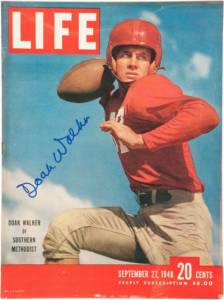 treatments he gave female gymnasts were legitimate). The majority of sports stories—for example, whether the Jacksonville Jags will sign a free agent DB, how some pro hoopster is upset because another has “disrespected” him or the fact that offense in major league baseball has largely devolved to strikeout or home run—leave me cold, but others do not. One that warms me considerably is a certain 88-year-old football stadium in Dallas’ Fair Park. I refer to the Cotton Bowl.
treatments he gave female gymnasts were legitimate). The majority of sports stories—for example, whether the Jacksonville Jags will sign a free agent DB, how some pro hoopster is upset because another has “disrespected” him or the fact that offense in major league baseball has largely devolved to strikeout or home run—leave me cold, but others do not. One that warms me considerably is a certain 88-year-old football stadium in Dallas’ Fair Park. I refer to the Cotton Bowl.
How significant was the Cotton Bowl to a sports-mad kid who grew up in Dallas during the 1950s and ’60s? There were other prominent college and pro football stadiums, but this one was ours. Its history gripped me and still does. Erected in 1930 at a cost of $328,000, it was originally named Fair Park Stadium. As much as I admire Doak Walker (1948 Heisman Trophy winner for SMU), he did not build the Cotton Bowl. “The house that Doak built”—oh, please. It was a Dallas 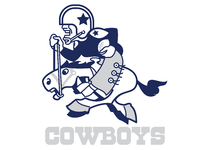 sportswriter’s catchphrase that somehow stuck. The popularity of Walker led to the construction of east- and west-side upper decks, raising seating capacity to more than 75,000. But since he was just 3 years old when SMU beat Indiana 27-0 on October 26, 1930 (the first game), he neither literally nor metaphorically built the stadium. The Mustangs called it home on a full-time basis starting in 1932, and the January 1 Cotton Bowl game commenced five years later. The Texas−Oklahoma game (again, I refuse to
sportswriter’s catchphrase that somehow stuck. The popularity of Walker led to the construction of east- and west-side upper decks, raising seating capacity to more than 75,000. But since he was just 3 years old when SMU beat Indiana 27-0 on October 26, 1930 (the first game), he neither literally nor metaphorically built the stadium. The Mustangs called it home on a full-time basis starting in 1932, and the January 1 Cotton Bowl game commenced five years later. The Texas−Oklahoma game (again, I refuse to 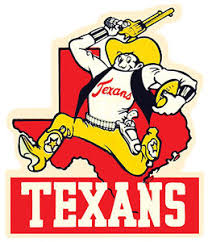 acknowledge phony names like “Red River Shootout”) has been held at the Cotton Bowl every year since 1932. I suppose this is the peak of the 24-day State Fair, of which I have many memories. For three hectic seasons (1960−1962), it was home to two pro football teams—the Dallas Cowboys of the NFL and the Dallas Texans of the AFL. As you probably know, Lamar Hunt’s Texans left for Kansas City in 1963; the Cowboys stayed there until 1971 before moving to Texas Stadium in Irving. SMU, having dropped from national prominence, opened a cozy on-campus stadium in 2000.
acknowledge phony names like “Red River Shootout”) has been held at the Cotton Bowl every year since 1932. I suppose this is the peak of the 24-day State Fair, of which I have many memories. For three hectic seasons (1960−1962), it was home to two pro football teams—the Dallas Cowboys of the NFL and the Dallas Texans of the AFL. As you probably know, Lamar Hunt’s Texans left for Kansas City in 1963; the Cowboys stayed there until 1971 before moving to Texas Stadium in Irving. SMU, having dropped from national prominence, opened a cozy on-campus stadium in 2000.
Glory days long past
The Cotton Bowl has been in decline for so long it’s hard to say when that process started. Although it has been modernized several times, there are limitations. The old girl, getting up in years, has no bells, no whistles. And modern sports fans have become a pampered lot. They like—neigh, demand—comfort and convenience. The Cotton Bowl’s seats are narrow, the plumbing sometimes does not work, and the amenities are  distressingly bad. There’s no getting around the fact that the stadium was built in the second year of the Depression.
distressingly bad. There’s no getting around the fact that the stadium was built in the second year of the Depression.
Jerry Jones, owner of the Cowboys since 1989, did not regard Texas Stadium as quite up to par. In 2004, he began making noise about building a bigger and better facility in one of the D/FW suburbs. This very shrewd businessman applied leverage in the form of the Cotton Bowl. He suggested (in fact, he had blueprints drawn up) a deal whereby it would be leveled and a modern retractable-roof stadium erected in its stead: a 21st-century football cathedral, good for the Cowboys, the bowl game, the Horns and Sooners, and the city of Dallas. This came to naught, of course. Texas Stadium was imploded in April 2010, and a $1.4 billion monstrosity in Arlington called AT&T Stadium became the team’s third home. I was pained and yet not surprised when the Cotton Bowl big shots moved the game there too.
Dallas buys time
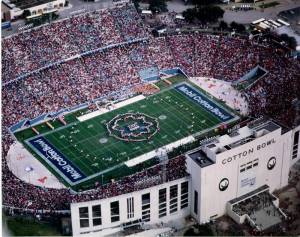 As for the stadium, in November 2006 Dallas voters passed a $50 million bond referendum whereby seating capacity was expanded to over 92,000, with new scoreboards, a VIP area, better restrooms, concessions and such. It was, in my opinion, just to keep the administrations in Austin and Norman happy. Payout to UT and OU was increased to $500,000 ($600,000 starting in 2021) each, and things are settled as far as the Longhorns and Sooners go—until 2025, at which time the contract expires. That’s seven years in the future, but if the schools don’t join the exodus to Arlington, I will be stunned. There has also been discussion of just holding the annual game at the two campus stadiums, a home-and-home arrangement. If tradition is the only reason to stay at the Cotton Bowl, it simply will not happen.
As for the stadium, in November 2006 Dallas voters passed a $50 million bond referendum whereby seating capacity was expanded to over 92,000, with new scoreboards, a VIP area, better restrooms, concessions and such. It was, in my opinion, just to keep the administrations in Austin and Norman happy. Payout to UT and OU was increased to $500,000 ($600,000 starting in 2021) each, and things are settled as far as the Longhorns and Sooners go—until 2025, at which time the contract expires. That’s seven years in the future, but if the schools don’t join the exodus to Arlington, I will be stunned. There has also been discussion of just holding the annual game at the two campus stadiums, a home-and-home arrangement. If tradition is the only reason to stay at the Cotton Bowl, it simply will not happen.
A replacement bowl game instituted in 2011 has gone by the names of Dallas Football Classic, Ticket City Bowl and Heart of Dallas Bowl. The days of the Southwest Conference (R.I.P.) champion facing off against an invited squad before a packed house with national championship implications—and let us not forget the Cotton Bowl Parade in downtown Dallas—are far in the past. What you have today are mid-level teams playing before tiny “crowds.” The most recent such contest featured Utah and West Virginia, and exactly 9,392 tickets were sold but even fewer people bothered to attend. Aerial photos of the stadium during the game reminded me of what Ross Perot used to say: “Now, that’s just sad.” In the six years the event has been going on, it has lost $2.4 million.
Cotton, Sugar, Orange and Rose
I am a long way from Dallas and the inner workings of city government, so I do not know about the future of the Cotton Bowl stadium. I just remember how, in my younger days, I would 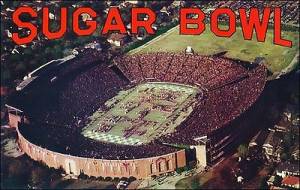 watch the Cotton, Sugar, Orange and Rose bowls on January 1. A college football marathon, these games enthralled me. But drastic change has come to three of the events.
watch the Cotton, Sugar, Orange and Rose bowls on January 1. A college football marathon, these games enthralled me. But drastic change has come to three of the events.
The Sugar Bowl was first played at Tulane University’s campus stadium in 1935. Built in 1926, it was expanded four times, up to a seating capacity of almost 81,000. The Green Wave called it home, of course, as did the New Orleans Saints for seven seasons before the Superdome was erected in 1975. The Sugar Bowl was moved there without delay. Super Bowls 4, 6 and 9 were held at Tulane Stadium, which was in terrible shape before being razed in 1980. TU, after 38 mostly unsatisfactory seasons at the Superdome, now has a much smaller on-campus facility.
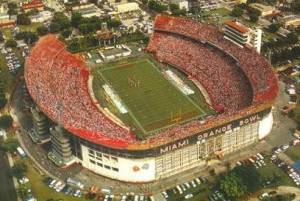 The Orange Bowl, built in 1937 and expanded five times, hosted its eponymous bowl game through 1996. The Miami Dolphins called the Orange Bowl home for 21 seasons before building their own NFL-standard facility, and the University of Miami played there through 2007. It hosted Super Bowls 2, 3, 5, 10 and 13. The stadium where the Dolphins and Hurricanes play has had no fewer than eight different names, and I have no desire to recapitulate them here. The Orange Bowl met the wrecking ball in May 2008.
The Orange Bowl, built in 1937 and expanded five times, hosted its eponymous bowl game through 1996. The Miami Dolphins called the Orange Bowl home for 21 seasons before building their own NFL-standard facility, and the University of Miami played there through 2007. It hosted Super Bowls 2, 3, 5, 10 and 13. The stadium where the Dolphins and Hurricanes play has had no fewer than eight different names, and I have no desire to recapitulate them here. The Orange Bowl met the wrecking ball in May 2008.
As for the Rose Bowl, the story is happier. Built in 1922 and expanded to seat 91,000 fans, it is home to the UCLA Bruins. While there is no thought of moving the New Year’s Day game elsewhere, it’s an old edifice with 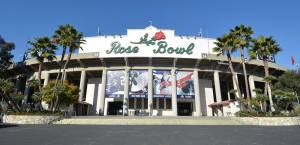 many of the same issues plaguing the Cotton Bowl. Actually, since the Cotton Bowl is in the middle of Fair Park, there is adequate parking; parking in and around the Rose Bowl is a nightmare. Super Bowls 6, 14, 17, 21 and 27 were held in Pasadena.
many of the same issues plaguing the Cotton Bowl. Actually, since the Cotton Bowl is in the middle of Fair Park, there is adequate parking; parking in and around the Rose Bowl is a nightmare. Super Bowls 6, 14, 17, 21 and 27 were held in Pasadena.
A questionable future
The Rose Bowl is outdated but in no danger of being demolished and replaced. Tulane Stadium and the Orange Bowl, as we have seen, are history. What, then, of the Cotton Bowl? It has no major tenant 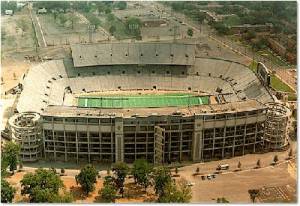 and hosts just one big event per year. White elephants are, by their very nature, expensive to maintain and bothersome as well. I hate to be a naysayer about a stadium I love so much, but I just do not see how Dallas can afford to keep it—especially if the UT−OU game leaves after 2025. Another venerable stadium, Legion Field in Birmingham, Alabama, is in a similar predicament. Erected in 1927 and once calling itself “the football capital of the South,” it has little raison d’être (its sole tenant, the University of Alabama-Birmingham, is leaving for a new and smaller stadium downtown in 2020) and struggles for relevance. It is literally crumbling. Legion Field means nothing to me; in fact, I have never set foot in Birmingham. The Cotton Bowl, however, is another matter.
and hosts just one big event per year. White elephants are, by their very nature, expensive to maintain and bothersome as well. I hate to be a naysayer about a stadium I love so much, but I just do not see how Dallas can afford to keep it—especially if the UT−OU game leaves after 2025. Another venerable stadium, Legion Field in Birmingham, Alabama, is in a similar predicament. Erected in 1927 and once calling itself “the football capital of the South,” it has little raison d’être (its sole tenant, the University of Alabama-Birmingham, is leaving for a new and smaller stadium downtown in 2020) and struggles for relevance. It is literally crumbling. Legion Field means nothing to me; in fact, I have never set foot in Birmingham. The Cotton Bowl, however, is another matter.

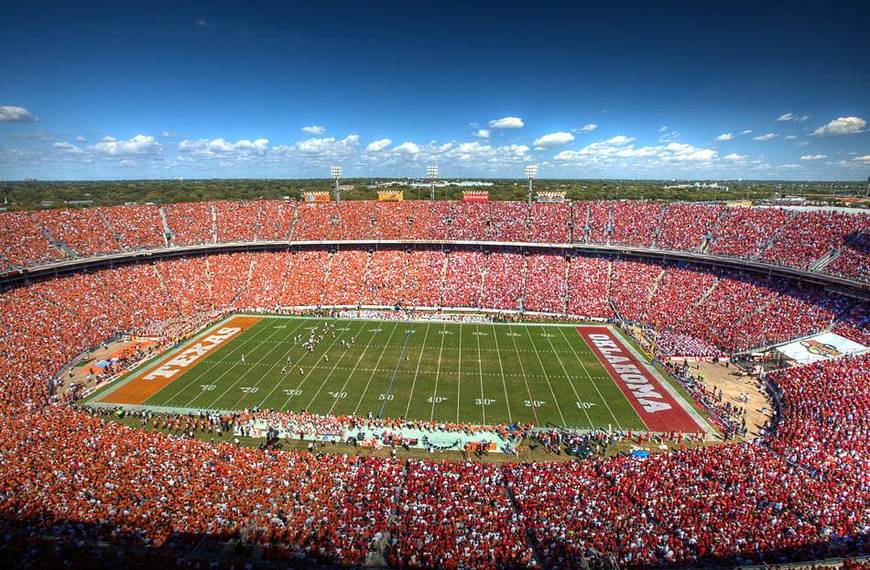
17 Comments
Thoughtful article about a subject that is close to the hearts of us Dallasite Boomers. I remember as a Belle during the ‘67 football season, BA played at the Cotton Bowl for, I want to say Quarter Finals against Richardson HS. As we stepped into the field, a surprise awaited us-AstroTurf. It was a very hard feel, and I wondered how this would affect performance. I remember thinking we should have practiced on the cement parking lot instead of the field. It was hard in comparison to a grassy field. The day the Cotton Bowl goes up in smoke will be a sad day. Terrific article, Richard.
I remember that game against Richardson, Tammy, even though I was still at Hill JHS. Having looked into this thing, I cannot conclude anything other than something sad happening. Maybe sooner or maybe later, but it will be gone. That bowl game they have now is a pale imitation of what we knew. It gets zero media attention. Contrast that with when the University of Georgia team arrived at Love Field in late December 1966…many stories and photos, etc.
I just got back from NCAA national track champs at Eugene Oregon. Prefontaine’s home. Most venerated track in the world. And it is getting demolished this year and being replaced with a $200 million dollar facility. Time marches on!
Did not know the venerable Prefontaine stadium (Heyward Field?) is coming down soon. Glad you got to see the meet, Kenny!
The rejection by the City of Dallas’ City Counsel of Jerry Jones’ plans to build a new stadium on the south side of the I-30 canyon next to the Sears Lamar Tower is the worst business decision I can think of. Next is their rejection of the idea to build the new stadium on the fair grounds. The third worst business decision was to not to allow the stadium to be built in Dallas thusly being built in Arlington. Mayor Laura Miller was inept by any measurement and personally led much of the bad decision making of the Dallas. Those were unproductive years while she led us.
City Counsel. Her background as only a journalist without any business acumen or pedigree says all we need to know why she was such a colossal failure in leading a $1 Billion dollar city budget and failed at being a visionary leader for a metropolis as big as Dallas.
That being said, you are exactly correct, the Cotton Bowl is about as useful as the Roman Colosseum as for as the amenities people want and expect. I say tear it down. That’s right get rid of it. Cancel the contracts with the Virginia and Utah boys. Send them to the ATT stadium in exchange for a monetary sum to be used toward building a stadium on the current Cotton Bowl site, one that is better than Jerry World. We have so many billionaires in Dallas, a consortium of 10 could build it with cash on hand and give Dallas the stadium it deserves.
Just saying…it just takes a vision…and there you have one.
I don’t think there was a thing Laura Miller could have done to convince Jones to put his stadium in Fair Park, Gary. He was “playing” her and the city. And when our dear old CB is razed, another big one is unlikely to replace it. The situation has devolved and will devolve further.
There may be larger or more glamorous stadia in the country, but coaching in the Cotton Bowl stadium was one of the most thrilling venues I ever experienced. With the tunnel and both teams coming out together the emotions of everyone were raised to the highest level.
Coach, you have a unique experience. People like me can only imagine what it’s like before, during and after a UT-Oklahoma game for players and coaches.
Richard-Interesting article that brought back lots of fond memories of going to Cowboy games in their early days. I agree with your take that since there is just not a home team for the stadium at this point, survival is doubtful. Football stadiums, to me anyway, just are not very attractive structures. Baseball parks, Camden Yards in Baltimore comes to mind, are much more attractive venues.
Kevin, it’s just a matter of time. I would say “keep your eye on 2025.” Once the Horns and Sooners leave, that will be it. Painful to consider, but I think it’s so. You saw how Dallas spent $50M to expand and fix it up in 2006? That’s not much money these days, and I have to think they did that stuff on the cheap. Wish I was there to inspect the stadium.
Richard:
I thoroughly enjoyed your article on the Cotton Bowl. I was good friends with Lindsay Nelson who, as you know, was the voice of the Cotton Bowl for decades. I especially liked the Life magazine cover of Doak Walker. Nice work!
Rex, I value your feedback very much. I should have mentioned Lindsay Nelson! Maybe it’s not too late. Thanks again.
To be honest, this article goes beyond my knowledge of the content 🙁 However, it is always good to know (or I should know) about the sport history!
Thank you.
I realize that this is a purely American sports issue. It would be hard for an “outsider” to understand all the issues. Nonetheless, thanks for reading and commenting.
I have a similar opinion like Anthony. I feel like I have a long way to go for understanding American sport history. But, as always, I enjoyed your writing. Thank you!
At least you read it, Bomin!! And thank you for having done so. If you grasp even a fraction, you are making progress in the broad field of American sports.
Add Comment